The weightlifting belt may well be one of the most controversial strength training accessories, in-part may be due to the lack of scientific literature on the use of the weightlifting belt in performance or injury prevention. As with all the strength training accessories there is a time and place for its use however it is important to understand the when and how of using the weightlifting belt. Unfortunately there is not a lot of reliable information or practical advice on weightlifting belts.
There are those that are against the use of the weightlifting belt while others support the use of the weightlifting belt for certain lifts. It is well accepted though that the weightlifting belt should not be used all the time during training as sometimes seen in gyms around the world. The truth may lay somewhere in the middle, leaning a little towards the group the opposes the use of the weightlifting belt.
First we should address come of the concerns and benefits for using the weightlifting belt.
Concerns to keep in mind with using a weightlifting belt.
1. Those who have never had a previous back injury appear to have no additional protective benefit from wearing a belt.
2. Those who are injured while wearing a belt seem to risk a more severe injury.
3. Wearing a belt while injured to support the injured area may lead to more serious injury or slow the recovery from the current injury.
3. Belts appear to give people the perception they can lift more.
4. Belts appear to change the lifting styles of some people to either decrease the loads on the spine or increase the loads on the spine.
Possible benefits of using a weightlifting belt.
1. Remind people to lift properly (when trained in its use).
2. Support shear loading on the spine that results from the effect of gravity acting on the hand-held load and mass of the upper body when the trunk is flexed.
3. Reduce compressive loading of the lumbar spine through the hydraulic action of increased intra-abdominal pressure associated with correctly wearing a belt.
4. Act as a splint, reducing the range of motion when applicable and thereby potentially decreasing the risk of injury.
5. Provide warmth to the lumbar region.
6. Enhance proprioception via pressure to increase the perception of stability.
7. Reduce muscular fatigue.
8. Provide stiffening to the torso to enhance performance.
As a general rule most individuals involved in strength training should not use a weightlifting belt the majority of the time however there maybe times where it may be beneficial with intermediate to advanced trainees or for those participating in lifting sports such as powerlifting, Olympic weightlifting or strongman.
In competitive strength sports (powerlifting, Olympic weightlifting and strongman) the weightlifting belt does play an important role as will allow more load to be lifted in the lifts. Due to the fact they are used in competition the individual needs to learn to train with the weightlifting belt also but must do so intelligently with planned programming involving periodization around the weightlifting belts use.
If the use of a weightlifting belt is indicated then the individual should first develop a strong base without the weightlifting belt and focus on maintaining that base while using the weightlifting belt. Movement patterns should be fully developed prior to using the weightlifting belt and focus should be maintained on form when utilizing the belt during the lifts.
The function of the belt should be to reinforce the core and not to create excessive compression of the abdominal region. The belt should be tight enough to support the bracing of the core but not so tight that it forces the position of the core into more of a hollowing position.
Powerlifting vs Olympic weightlifting belts.
Chose the right tool for the job. Weightlifting belts are designed for a specific job while also rules involve in the sport may also limit the type of belt that can be used.
Powerlifting belts are generally 6″ i
n width and may restrict some mobility. They should be generally very stiff and mad from leather. The quality of the belt does matter as cheaper belts may loose some of the stiffness over time. The thickness of the belt is usually at least 10mm but depending on the size of the individual a thicker belt maybe used. These belts can also be used in strongman training
It should also be noted that the maximum width of a belt permitted to be used in Olympic weightlifting competition is 120mm (~4.7″) and 100mm (~4″) for powerlifting competition. Maximum thickness for powerlifting is 13mm however there does not seem to have a limitation on thickness in Olympic weightlifting, but a thicker belt may not be an advantage. Strongman competition does not seem to have a standardized width or thickness.
The closure mechanism of the belt should also be taken into consideration. The traditional belt buckle is limited in its ability to adjust to the individual lifter as with the lever closure, however some may find these will work for them however important to point out these will not be as adjustable in the future if the waist circumference changes. The advantage of the lever closure is the quick release after the lift and possibly easier to tighten before the lift. With the traditional buckle there is the single-prong, double-prong buckle however generally one is not better than the other but rather based on personal preference. The ratchet closure mechanism allows for the most adjustability however many federations ban the use of the ratchet closure mechanism. These ratchet belts are generally far more expensive but for the serious lifter that is not restricted from using the ratchet belt, it may be a good choice when looking for a belt.
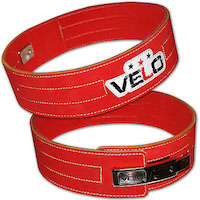
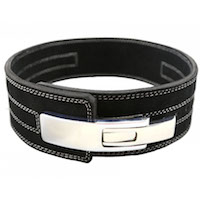
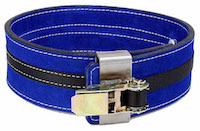
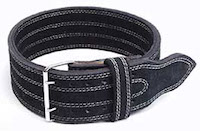
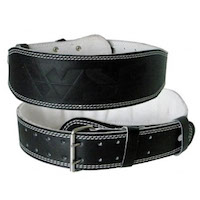
If you are competing in a strength sport you should always check with the rules under the federation that you are competing with as their rules may vary slightly. You maybe also limited to certain manufactures under some federations.
Tapered Weightlifting Belts
Tapered belts where the belt in thinner in the front (as illustrated below) does not provide the same improvement in performance than belts that are the same idea width the entire circumference of the belt. This does not mean they cannot be used but will not be as effective as the non-tapered belt. It may also be useful in smaller individuals esspecially those with a small gap between your ribs and their hips.
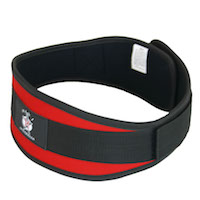
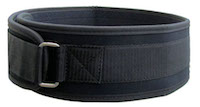
Leather vs Synthetic Weightlifting Belts
When comparing leather to nylon or synthetic weightlifting belts there is not much to compare. Leather belts are superior to nylon or synthetic due to the stiffness and support it provides. A quality leather weightlifting belt will also last a lot longer than a belt made from nylon or synthetic material. Again many federations will not allow their use. I would not recommend any nylon or synthetic weightlifting belts.
Padded Weightlifting Belts
Belts may also have added padding in the back portion at add more comfort and some suggest it adds more support in the lumbar region. Padding will add thickness to the belt thus disqualifying it for many competing in strength sports where there is a restriction in the thickness of the belt. The notion that it adds more support in the lumbar region may have some logic to it however is invalid do to the fact that the padding is soft and will not create any real support. The suggestion of comport may have more credit but comport is not the priority when selecting a weightlifting belt beyond selecting the correct sizing and thickness of the belt.
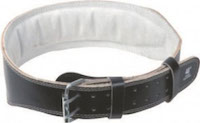
Programming for the Weightlifting Belt
Programing in the use of the weightlifting belt into your overall strength training program should be limited to only times where maximum loads are absolutely necessary and should only be used on certain qualified lifts. This should only be applied to the intermediate to advanced trainee and never used in the beginner trainee.
If you need to use the weightlifting belt for competition then more time maybe allocated with using the belt on non-maximal lifts to improve your technique while using the belt.
